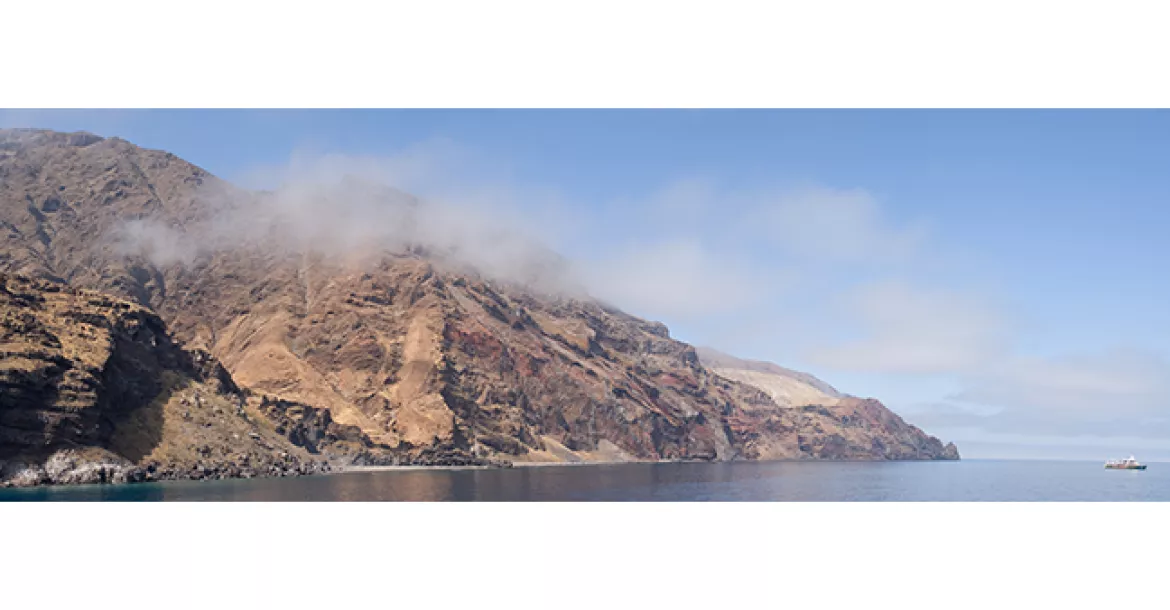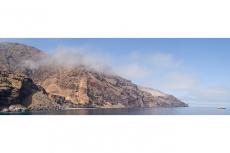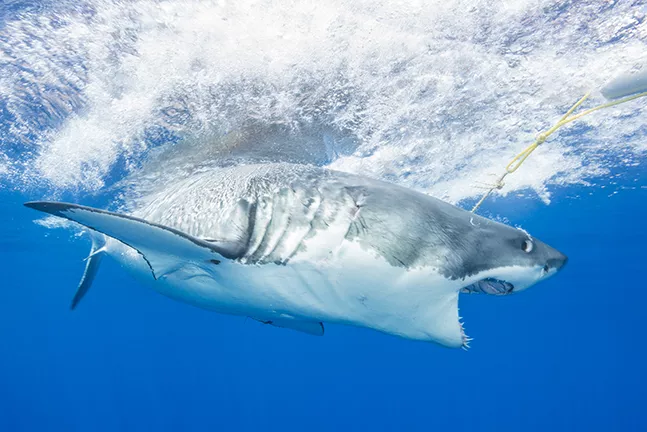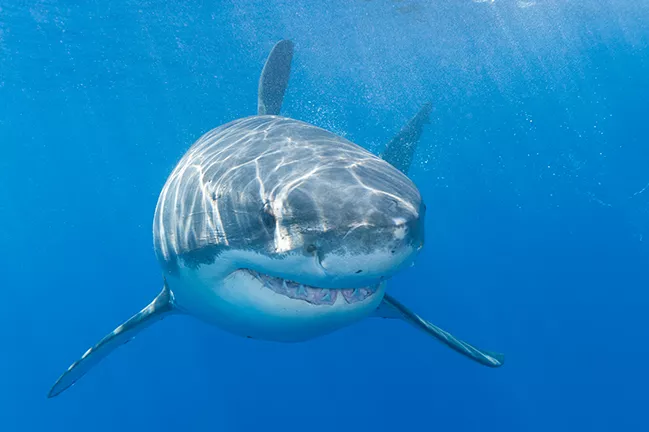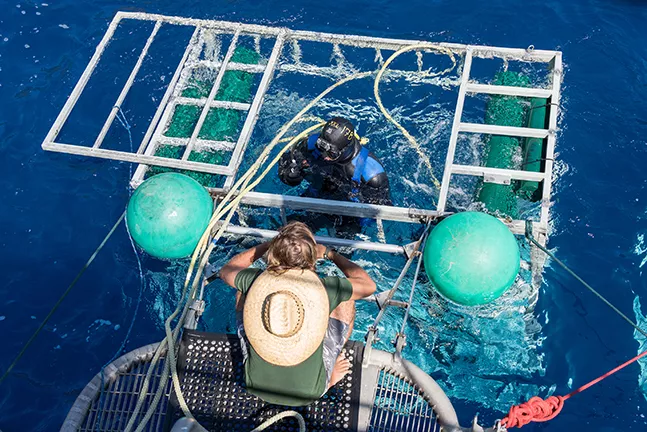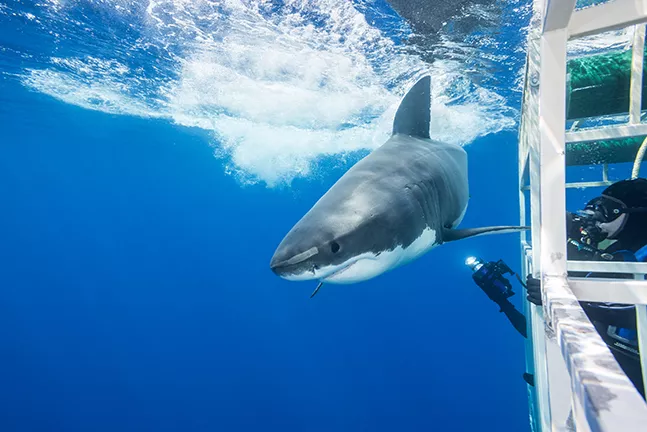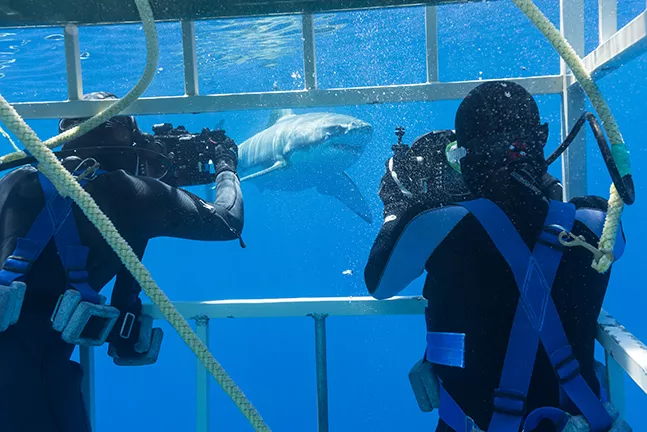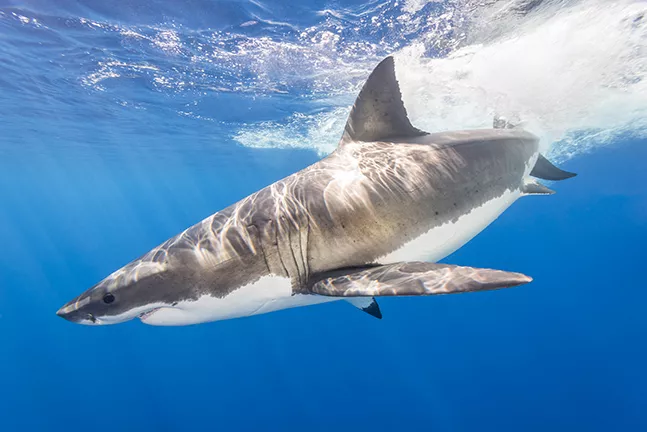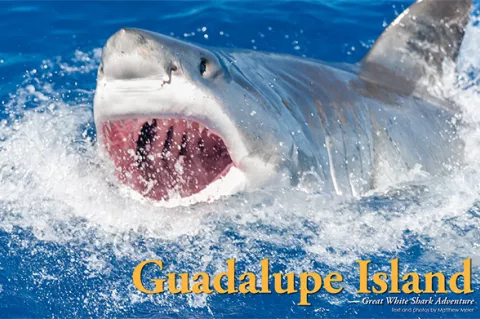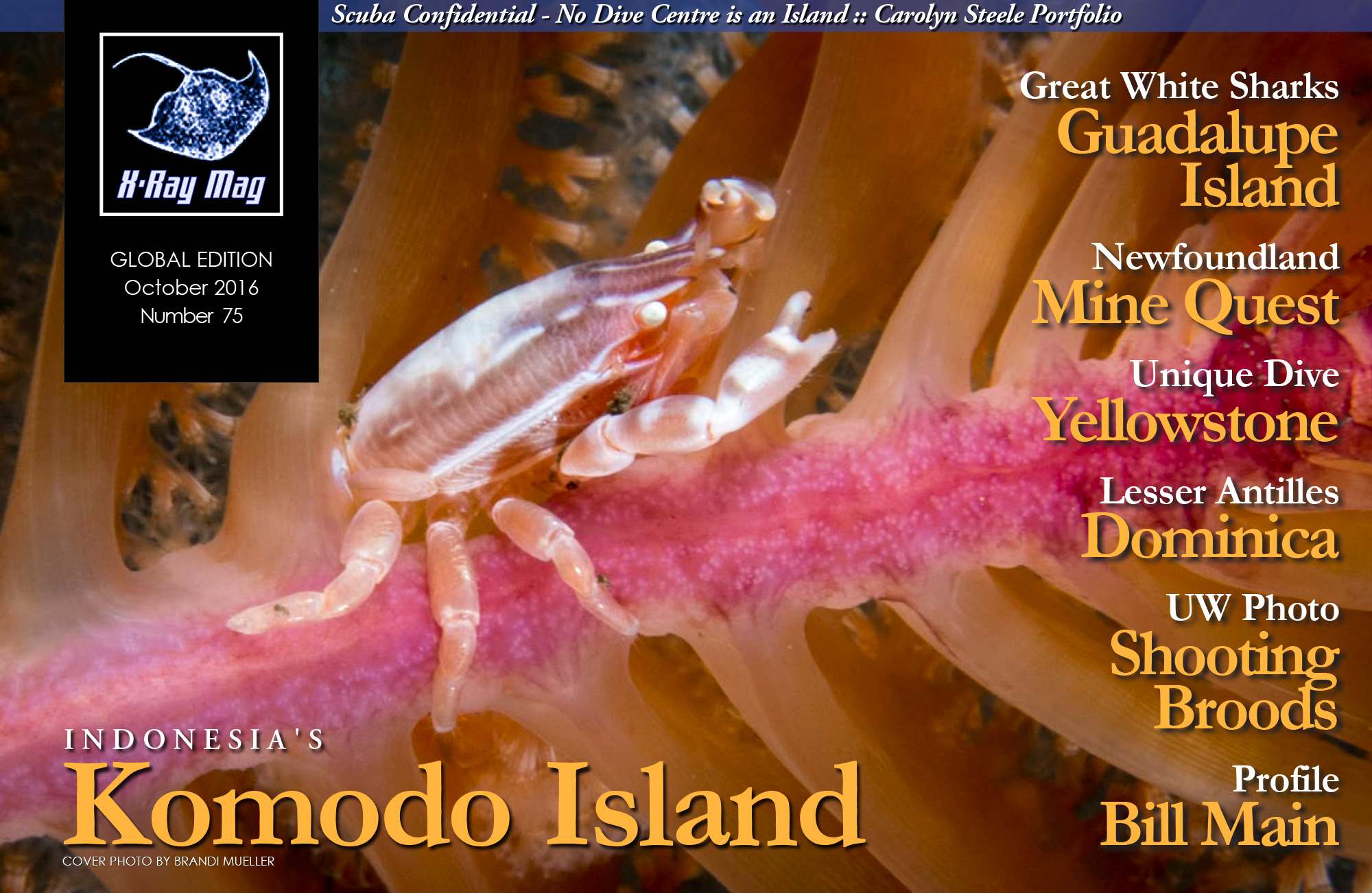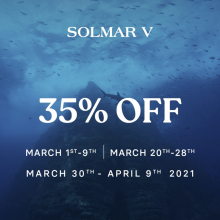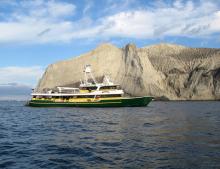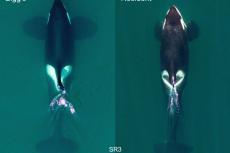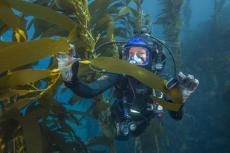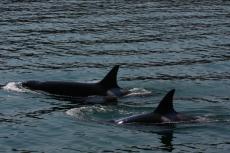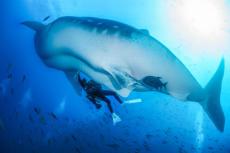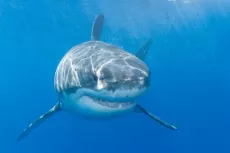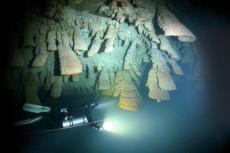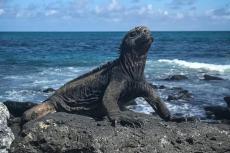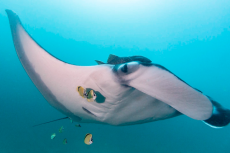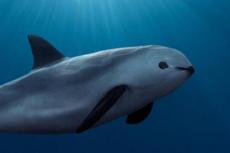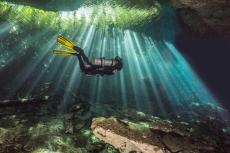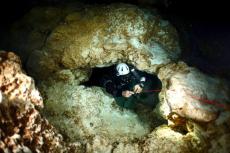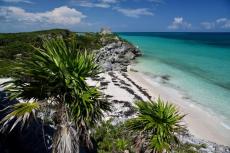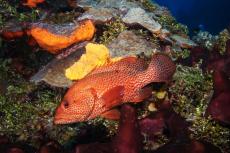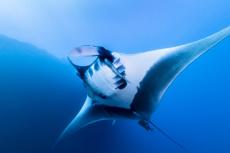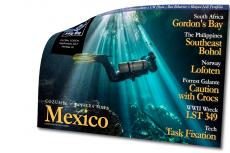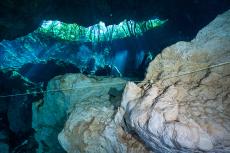Rising out of the depths, a shape emerges from the shadows, methodically swimming in a wide arc. The outline is unmistakable, as it continues to climb and inch closer at every turn. With one last pass, seemingly in slow motion, I am struck by the sheer enormity of the creature in front of me.
Visions of Martin Brody voicing his famous line, “You’re gonna need a bigger boat,” play through my head. Fortunately, I am not on a small fishing boat, nor is this the demonic, mechanical shark from the movie "Jaws".
Contributed by
Factfile
Matthew Meier is a professional underwater photographer and travel writer based in San Diego, California.
To see more of his work and order photo prints, please visit: Matthewmeierphoto.com.
CLIMATE & CONDITIONS: During the months of August, September and October, when great white shark trips are in operation, the average air temperature at the island is 75°F (24°C), but record highs have reached up to 90°F (32°C). The relative humidity is steady at 80%, with an average monthly rainfall only a few millimeters. Water temperatures can be as warm as 75°F (24°C) in August and may cool down to as low as 62°F (17°C) by the end of October. A 7mm wetsuit or a dry suit is recommended for warmth in the cage.
TRAVEL/VISA: A valid passport is required to enter Mexico and a free, temporary visa is issued at the border crossing when driving from San Diego down to Ensenada to board the boat.
CURRENCY: The Mexican pesos is the official currency but given that all trips to Guadalupe Island originate in San Diego, California, US dollars are the default currently on board.
HYPERBARIC CHAMBERS: The nearest chamber to Guadalupe Island is at least 150 miles away on the mainland. Hopefully, given that most of the time you will be standing in a cage in less than 10 feet of water, the probability of needing hyperbaric attention should be very slim.
VOLTAGE: The voltage on the liveaboard dive boats can be either 110 or 220 and they will often offer both. The outlets are typically of US prong configuration
Today begins my three-day adventure: cage diving with great whites at Guadalupe Island. And my excitement level is skyrocketing after the first face-to-face meeting with these massive sharks.
There is no way to truly put into words the exhilaration of seeing a great white shark swim past you, only a few feet away. I have jumped out of airplanes, skied off 80ft (24m) cliffs and run with the bulls in Spain, but nothing quite compares to the rush of being eye to eye with the ocean’s top predator.
Even more amazing is that anyone can dive with great white sharks at Guadalupe Island. No scuba diving certification is required. Photographers, videographers, shark enthusiasts and adventure seekers travel here from around the world, because nowhere else on Earth is there the warm, clear, blue waters and consistent shark sightings that have made Guadalupe Island the premier destination for great white sharks.
Cage diving
My first experience cage diving with great white sharks was several years ago, and I will never forget the elation and slight trepidation of dropping into that water for the first time. I had been a certified diver for nearly 25 years and witnessed numerous shark species up close in the wild, but somehow, the stigma of the great white made this experience different.
Next to me in the cage was a young couple that had never seen a shark underwater, much less a great white. In fact, they had never even scuba dived before. They were so ecstatic and animated that they could not sit still, and were bouncing around the cage to make sure they did not miss a thing.
When the first shark swam past, the cage was shaking so badly from their leaps of joy that I could not even take a picture. The couple’s excitement persisted for three straight days, though they did thankfully stop rattling the cage. I have since returned several times to see the great white sharks and still share their enthusiasm each time I visit.
Guadalupe Island
Guadalupe Island is located in the Pacific Ocean, roughly 180 miles (~290km) southwest of Ensenada, Mexico. A few hundred fishermen, spread out over a handful of villages, live on the island at various points during the year; otherwise, Guadalupe is largely devoid of humans.
The island is volcanic in origin, with mountain peaks rising over 4,200ft (~1,280km) out of the ocean at the northern end. Localized weather at these higher elevations creates dense fog banks, which roll over the leeward side of the island and condense into moisture to sustain the island's vegetation.
Guadalupe Island is home to several species of pinnipeds including elephant seals, Guadalupe fur seals and California sea lions. Hunted to near extinction in the mid-19th century, the seal's numbers have since rebounded under the protection of the Mexican government. Hundreds, if not thousands, of seals line the shore and their calls can be heard from far across the waters. This readily available food source is likely one of the reasons so many great white sharks visit Guadalupe Island in late summer and fall every year.
Operators
Several pioneers in the diving industry helped introduce the world to the great white sharks at Guadalupe Island. In the mid-1980s, underwater filmmakers and photographers Marty Snyderman and Bob Cranston established a company to take guests diving with blue sharks off the coast of San Diego. Following an episode of "Mutual of Omaha’s Wild Kingdom", in which Marty filmed great whites at Guadalupe, they began offering great white shark trips to their clients. Another innovator was Carl Roessler of See & Sea Travel, Inc., the world’s first and largest travel agency dedicated to dive travel. Carl not only ran trips to Guadalupe through his agency, but he also helped manage the bookings for Bob and Marty for their blue and great white shark trips.
Today, all boats operating at Guadalupe Island begin their great white shark adventures in San Diego, California. Most transport guests by bus down to Ensenada, Mexico, where the passengers board a liveaboard dive boat for an 18- to 22-hour transit to the island. During the ocean crossing to and from Guadalupe, visitors have a chance to see blue and humpback whales, pods of dolphins and other cetaceans.
Upon arrival at the island, the boats anchor in a sheltered bay called the Northeast Anchorage, and set out with their shark cages for three days of diving. Guests take turns in the cage, typically alternating an hour in the water with an hour on deck.
The Solmar V was the first luxury liveaboard to operate at Guadalupe and has been shark diving in these waters since 2005. The boat offers two surface cages, which hold four divers each, and a two-diver submersible cage. All air is surface supplied via a hookah system, so guests can move freely about the cage, without the need for bulky BCs or tanks.
Divers are supplied with a 30 to 50lb (~13-23kg) weight harness, so they can stand solidly on the floor of the cage and wear only a wetsuit, boots, gloves, hood and a mask. The water temperature at Guadalupe ranges from the low to mid-70°F (~20°C) at the start of the season in August to potentially the low 60°F (~15°C) at season's end in October, so a 7mm wetsuit or a drysuit is recommended for warmth.
Observing sharks
Time in the cage is spent in anticipation, scanning the blue waters and the shadows lurking below. This relative calm is often interrupted by bursts of activity when a shark rockets to the surface in an attempt to eat the bait that is used to bring them close for photos and videos. The grace and power of the great whites is mesmerizing to observe as they transition from slowly swimming around the cage to turning and exploding towards the surface in the blink of an eye.
The length of a passing shark is difficult to judge underwater, though knowing the surface cage is 9ft (~3m) across helps with making rough estimates. The immense girth of the larger sharks gives a better indication to the shark’s size and is even more impressive the closer they approach.
Early in the season, the populace is made up mostly of males, with the larger females typically arriving later in September or October. The younger males can be very active and put on quite a show as they circle the cages attempting to feed on the bait.
During my most recent trip, we had three, four and even five sharks circling the cages at once. This kind of adrenaline-pumping action is nearly as much fun for the folks watching from the boat as it is for the divers, since the 100+ft (30+m) visibility at Guadalupe Island makes it almost as easy to track the sharks from above as below. Moreover, if the sharks are actively pursuing the bait, they will often breach partially out of the water, allowing for incredible topside photo opportunities.
Remote
One of the things I truly enjoy about traveling to Guadalupe Island, besides the white sharks, is being disconnected from the rest of the world. There is no email or phone service to disrupt you from getting to know your fellow passengers, sharing stories, photos and videos from your day with the sharks.
Don’t feel like talking? Perhaps you would prefer to sit under the stars on a lounge chair, enjoying your favorite after-dinner beverage, as you revel in the quiet serenity of this remote corner of the ocean. Maybe you would rather sit in the sun, watch a movie or simply curl up with a book in your cabin—whatever your pleasure, there is plenty of time to relax and recharge while on the boat.
Marine life
Even though the great whites are the main attraction, it is possible to see other marine life from both the cages and the boat. Schools of mackerel scad and yellowtail often feed on the bait near the surface, fleeing to hide behind the relative safety of the cage whenever a shark appears.
Seagulls float on the surface and peck at the bait, though they must be wary of becoming an easy meal for the sharks below. The infrequent sea lion will materialize to greet the boat and swim circles around the sharks, while large yellowfin tuna dart up from the depths for a free meal. Occasionally, dolphins will swim past in the bay, and last year, we even had a sea turtle visit the bait, only to be rudely displaced by a hungry white shark.
Options for divers
Certified scuba divers have the option of descending to 30ft (~9m) in the submersible cage to view the sharks from a completely different perspective. The cage is dropped into the water off the side of the boat and a divemaster controls the ascent and descent rate by talking to a topside operator through a full-face communication mask. Once at depth, the divers can observe the sharks swimming a full 360 degrees around them and also watch the sharks' interactions with the surface cages.
I think you get a better sense of the great whites’ true behavior from the submersible cage, as there is no bait to entice them closer. The sharks are cautious and make slow, wide circles while they observe you at the same time as you are watching them. These are intelligent animals, with an obvious self-preservation instinct—they are simply not the mindless, killing machines depicted in the movies.
Mobile cage future
The next evolution of shark diving may be a mobile cage. If you are a fan of Discovery Channel's "Shark Week," you will undoubtedly have already seen this device in action. We were lucky enough to get a close-up look at it during our latest trip to Guadalupe. A videographer from the Discovery Channel had arranged to have the cage on board so he could swim alongside and film the great whites in open water.
The cage is driven by a pilot sitting in the back while communicating via full-face mask with the camera operator in the front. I have no idea if or when regular guests will be allowed to sign up for this privilege, but I know my wish list just got a little bit longer.
Research
Several researchers have been studying the great white sharks at Guadalupe Island from as early as 1999. Dr Mauricio Hoyos is stationed on the island during the great white season and has been studying the shark population since 2004. The small boat that serves as his mobile office platform is often shorter than the sharks he is observing.
Mauricio’s work includes tagging, photo identification, tissue biopsies and educational talks on board the visiting dive boats. He is also one of the co-founders of Pelagios Kakunjá, a Mexican nonprofit organization dedicated to the conservation of sharks and pelagic species.
Photo identification database
The Marine Conservation Science Institute has compiled a comprehensive photo identification database, which has documented well over 150 individual great white sharks at Guadalupe Island. They also use satellite tags to track the shark’s movements, depth and water temperature to gain knowledge of their migration patterns and behaviors. Some of the sharks have returned to the island every year since they were first identified by their unique color and dorsal fin patterns.
The scientists welcome photos from the general public to aid in their research and use the photos to keep tabs on which sharks are at the island. If your submitted images reveal a new shark, you may have the opportunity to name it. I was lucky to have a new shark identified through my photos taken back in 2010 and was pleased to name him “Maximilian” in honor of my nephew. To contribute photos to this project, please visit their website.
Protection
Sharks are in need of protection the world over, and the great white is no exception. Millions of sharks are killed every year, primarily for their fins, and these fishing activities are decimating the populations of our oceans’ top predators.
Officially, the great white shark is listed on the International Union for Conservation of Nature’s (IUCN) Red List of Threatened Species, as “Vulnerable.” This specification is only two steps removed from being declared "Critically Endangered".
To quote the environmentalist, Baba Dioum: “In the end, we will conserve only what we love. We will love only what we understand. We will understand only what we are taught.” Wildlife encounters, like the ones with the great white sharks at Guadalupe Island, teach us to better appreciate and understand the natural world around us and encourages its protection and conservation.
If you are ready for an adventure of a lifetime, then it is time to visit Guadalupe Island and come face to face with the great white shark in its natural environment. I promise you will walk away a changed person, with an entirely new outlook on these incredible animals. The sharks need our help and protection as much as we need them for a healthy ocean and a healthy planet. This is a bucket-list trip for a reason. I hope to see you underwater at Guadalupe Island soon. ■
The author would like to thank the Solmar V (Solmarv.com) for their amazing hospitality and support on this adventure.

